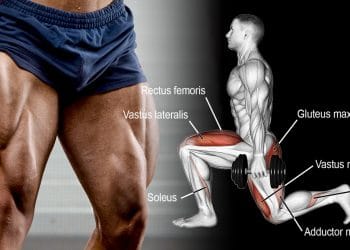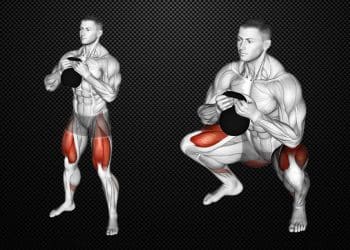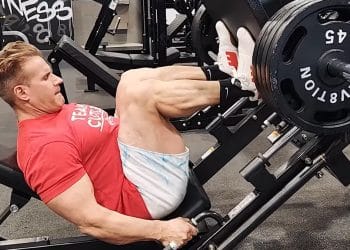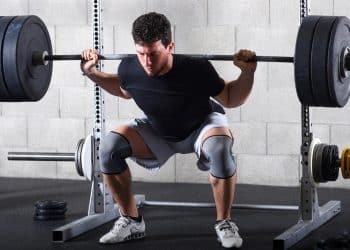A workout is not really a workout if it doesn’t include at least one variation of squats. The squat is often called the king of exercises, which should give you an idea of just how productive squats can be.
You can use squats to build lower body muscle, increase leg strength, improve power and performance, and even burn fat. They really should be a part of everybody’s workouts!
That said, there are several different types of squats, and what works well for one person may not be suitable for another.
In this article, article, we’re going to look at the benefits and differences between dumbbell squats and barbell squats, so you can choose the best option for your needs and goals.
Dumbbell Squat 101
If you’ve never done squats before, the dumbbell squat is a great place to start. Holding a dumbbell in each hand means that this exercise is comfortable, safe, and relatively easy to learn. As an added advantage, you don’t need a squat rack to do dumbbell squats, so it’s an excellent exercise for home lifters.
However, on the downside, the dumbbell squat is not a widely recognized lift, and nor is it part of powerlifting or Olympic weightlifting. But if you are looking for a gateway exercise to barbell squats, the dumbbell squat is an excellent option.
Level Up Your Fitness: Join our 💪 strong community in Fitness Volt Newsletter. Get daily inspiration, expert-backed workouts, nutrition tips, the latest in strength sports, and the support you need to reach your goals. Subscribe for free!
Muscles Worked
The dumbbell squat is a compound exercise, which means it involves multiple muscles and joints. And while squats are most definitely a lower body exercise, the dumbbell squat involves the upper body, too, making it a very functional, time-efficient workout.
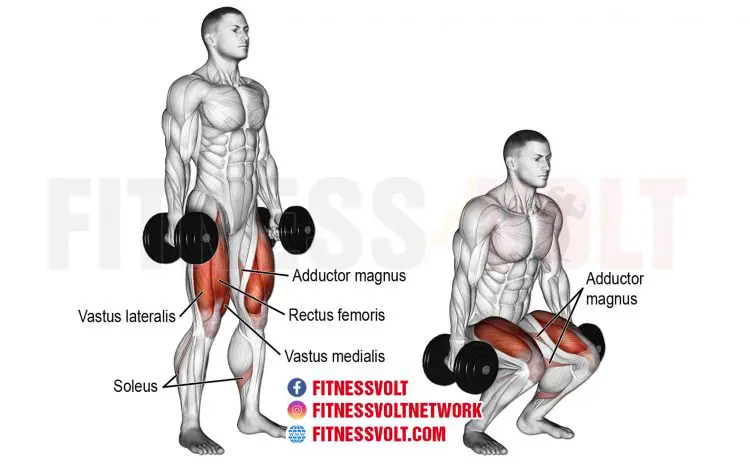
The main muscles developed during dumbbell squats are:
- Quadriceps – located on the front of your thighs, the quads are the main muscle trained during dumbbell squats. There are four quadriceps muscles: the rectus femoris, vastus lateralis, vastus medialis, and vastus intermedius.
- Gluteus maximus – the glutes are basically your butt. This is the largest and potentially strongest muscle in the human body. The deeper you squat, the more work the glutes have to do. The glutes extend your hips.
- Hamstrings – located on the back of your thighs, the hamstrings oppose your quadriceps and are responsible for knee flexion and hip extension. The three hamstrings are the biceps femoris, semimembranosus, and semitendinosus. While the hamstrings are most definitely involved in squats, they’re not as active as the quads, so they probably need to be trained separately to develop them fully.
- Adductors – the adductor muscles are responsible for pulling your legs in toward the midline of your body. Located on the inside of your thighs, the three adductor muscles are the longus, brevis, and magnus. During dumbbell squats, the adductors prevent your knees from falling outward.
- Abductors – opposing the adductors, the abductors lift your leg out and away from the midline of your body. Located on the outside of your hips and thighs, the three abductors are the gluteus minimus, gluteus medius, and the tensor fascia latae. During dumbbell squats, the abductors work to stoop your knees caving inward.
- Core – this is the collective term for the muscles of your midsection, including the rectus abdominis, obliques, transverses abdominis, and erector spinae. These muscles help stabilize your lumbar spine and prevent unwanted movement during dumbbell squats.
- Trapezius – located on your upper back, the traps stabilize your shoulder girdle so you can hold your dumbbells steady. There are three sets of trapezius fibers – upper, middle, and lower. The upper and middle fibers are most active during dumbbell squats.
- Biceps – the biceps are probably the most well-known muscle in the human body. During dumbbell squats, your biceps must work to prevent hyperextension of your elbows. They work isometrically or statically, which means they don’t produce any movement. However, especially with heavy loads, the biceps get a great workout from dumbbell squats.
- Forearms – your forearm muscles can be divided into two broad groups – flexors and extensors. During dumbbell squats, you’ll need to use your forearm flexors to maintain a firm grip on your dumbbells. In fact, your grip may determine how much weight and how many reps you can do of dumbbell squats more than leg strength.
How to do Dumbbell Squats
Get the most from dumbbell squats by performing them correctly!
- Holding a dumbbell in each hand, stand with your feet about shoulder-width apart, toes turned slightly outward. Brace your core and pull your shoulders down and back. The weights should be outside your thighs.
- Look straight ahead, inhale, and bend your knees. Squat down until your thighs are roughly parallel to the floor without rounding your lower back. It’s normal to lean forward slightly, but this should not be excessive.
- Drive your feet into the floor and stand back up, exhaling as you ascend.
- That’s one rep – keep going!
Tips:
- Adjust your squat depth based on your flexibility and knee health. Not everyone can or should squat below parallel.
- Use lifting straps if your forearms and grip fail before your legs.
- Place your heels on weight plates or wooden blocks to increase your range of motion and hit your quads harder.
- Consider wearing a weightlifting belt for dumbbell squats to support your back and lift more weight safely.
- This exercise works best when done for medium to high reps with a moderate to light load, e.g., 8-20.
Dumbbell Squat – Pros
Not sure if dumbbell squats deserve a place in your next leg workout? Consider these benefits and then decide!
- Easy to learn – with the weight down by your sides, dumbbell squats are far easier and more forgiving than barbell squats. It’s less challenging to maintain your balance and posture, and you don’t have to worry about resting a heavy bar on your upper back, which can be uncomfortable. This is the ideal weighted squat variation for beginners.
- Increased safety – squatting to failure with a barbell on your back can be dangerous. There is a risk that you’ll find yourself pinned under a heavy weight. There is no such risk with dumbbell squats. If you cannot complete a rep, you can simply lower or drop the weights to the floor.
- Low-tech but high effect – the only equipment you need to do dumbbell squats is a pair of dumbbells. In contrast, barbell squats invariably mean using a squat rack. If you work out at home, you may not have room for a squat rack, and cleaning the bar to your shoulders is impractical. As such, dumbbell squats are the ideal exercise for home lifters.
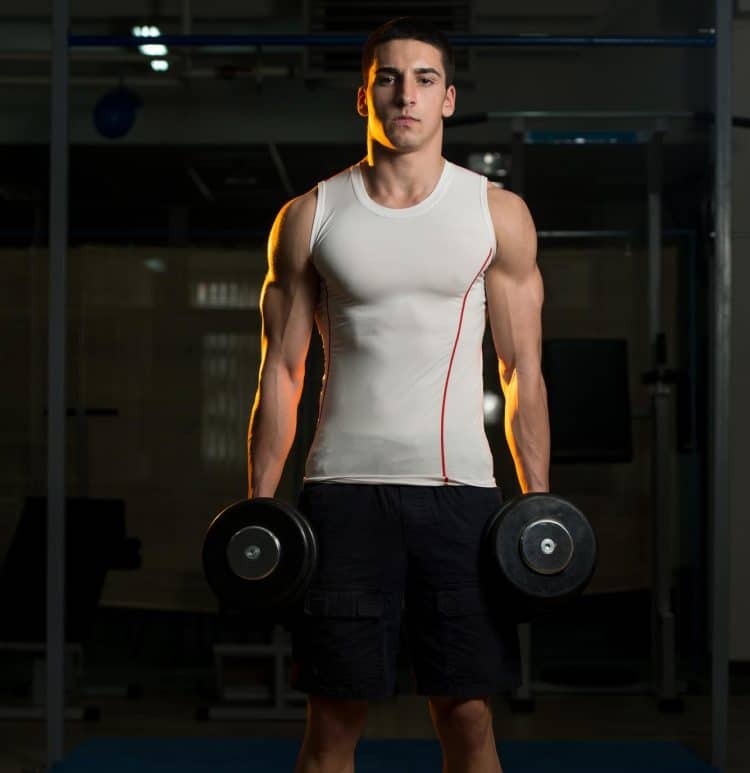
Dumbbell Squat – Cons
There are a couple of disadvantages to consider before you add dumbbell squats to your workouts…
- Grip strength – you need strong hands to do dumbbell squats, especially if you plan on doing high reps or using heavy weights. It’s not uncommon for the hands to fatigue long before the legs. The good news is that you can get around this problem by using wrist wraps and working on your grip strength.
- Limited overload – unless you work out in a well-equipped commercial gym, you may find that even the heaviest pair of dumbbells are too light to deliver a good workout. Your legs and glutes are very strong, and doing squats with a couple of ten-pounders won’t provide much of a workout for your lower body.
- A somewhat awkward movement – when you do dumbbell squats with heavy weights, you may find the weight rubs awkwardly on the side of your legs. It may even hit your knees. This could be quite off-putting and is not an issue you’ll get with barbell squats. For this reason, a lot of lifters turn to trap bar squats if they want to train with heavier loads.
Barbell Squat 101
Barbells were made for squatting! The barbell squat is one of the best exercises for building muscle mass and strength. There are several ways you can use a barbell for squats, including back squats, front squats, Zercher squats, and overhead squats. Each one works the same muscles, but the position of the bar affects the feel and performance of your chosen squatting exercise.
On the downside, unless you are a proficient weightlifter and can do power cleans, you will need squat stands or a power rack to do squats, especially if you plan on lifting heavy weights.
The barbell squat is one of the exercises contested in powerlifting and a common strength exercise for athletes. Bodybuilders love barbell squats as they’re one of the best moves for building bigger quads.
Muscles Worked
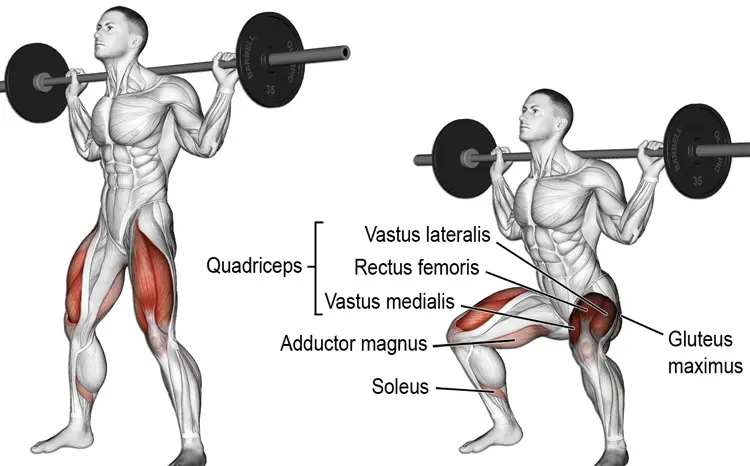
Barbell squats work many of the same muscles as dumbbell squats. The only thing they don’t really involve is the forearms and biceps. Everything else is much the same. But, to save you from scrolling back to see what muscles barbell squats train, here’s a simplified list of the main muscles developed during barbell squats.
- Quadriceps
- Gluteus maximus
- Hamstrings
- Abductors
- Adductors
- Core
How to do Barbell Squats
Exact barbell squat performance depends on the variation you are going to do, i.e., front, back, Zercher, etc. So, while the basic movement is essentially the same, there are minor variations based on how and where you position the bar.
To save you from wading through long sets of instructions that aren’t relevant to the type of squat you favor, here are links to the main barbell squat variations:
Barbell Squat – Pros
They might be the king of exercises, but are barbell squats the right exercise for you? Consider these pros before you make up your mind!
- A versatile exercise – depending on how you load them and how many reps you perform, you can use barbell squats to achieve almost any muscular fitness goal, from brute strength to inexhaustible endurance.
- Lots of variations to try – dumbbell squats are basically an alternative to barbell squats, but there is more than one way to squat with a barbell. Just switching from barbell back squats to front squats will have a significant impact on your workout.
- A widely performed exercise – most gyms have at least one rack for the performance of barbell squats. A lot of home lifters also have a squat rack or basic power cage for safer squats. Barbell squats are a very widely performed exercise. While that in itself is not a pro, it does suggest that this exercise has mass appeal and is very productive.
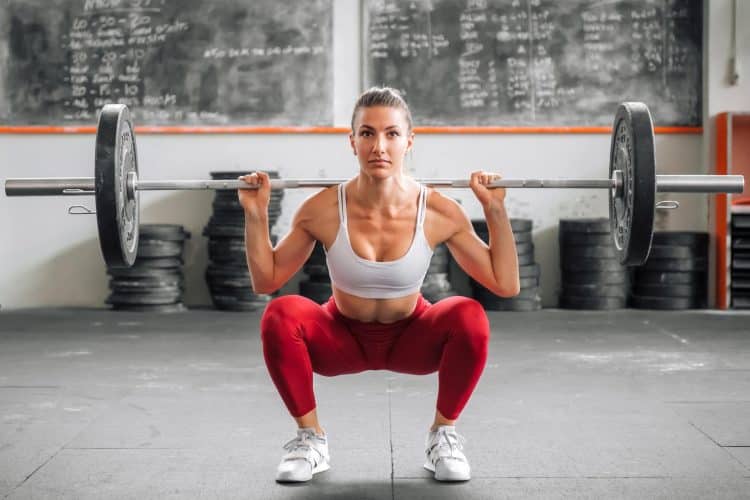
Barbell Squat – Cons
While barbell squats are a popular and effective exercise, there are some drawbacks:
- Safety – barbell squats to failure are a risky proposition at the best of times, but without a squat rack, it’s an accident waiting to happen. Getting squashed under a heavy barbell can result in severe and potentially career-ending injuries. For safety, squats are best performed in a power rack with the side safety bars set in place.
- Discomfort – resting and holding a heavy barbell on your back, the fronts of your shoulders, or in the crooks of your arms can be uncomfortable. It IS something you get used to, and your body may even lay down extra tissue for protection – sort of a natural squat pad. However, initially, at least, you will probably find barbell squats don’t only hurt your legs but the place where the barbell comes into contact with your body. You may have to use a folded towel or similar to make squats more tolerable.
- A challenging exercise to master – all types of barbell squats are considerably more difficult than dumbbell squats. The barbell squat is a surprisingly technical exercise, and doing it incorrectly can lead to injuries and poor results. You may require instruction and even coaching to squat with perfect form.
Dumbbell Squats vs. Barbell Squats
So, now that you know a little more about dumbbell squats and barbell squats, let’s judge these exercises by a few different criteria:
Dumbbell Squats vs. Barbell Squats: Strength
If you want to get brutally strong, the barbell squat is the way to go. With the bar resting on your shoulders, you can focus almost exclusively on lifting the heaviest possible weights – using a squat rack for safety, of course!
In contrast, with dumbbell squats, your training weights are limited by your grip strength, so you may find that your hands fail before you fatigue your legs.
Both exercises have the potential to make you stronger. Still, if maximal strength is your goal, the barbell squat is your best training option. There is a reason that powerlifters and strongmen mostly perform barbell squats!
Winner: Barbell squats.
Dumbbell Squats vs. Barbell Squats: Hypertrophy
Providing you take your sets to within a couple of reps of failure, you can increase muscle size using either dumbbell squats or barbell squats. However, you will need a firm grip; otherwise, your hands may fatigue before your legs.
Because of this, beginners should be able to build muscle with dumbbell squats. Stronger, more experienced lifters will probably need to graduate to barbell squats.
Winner: It’s a draw, but dumbbell squats are probably better for beginners. At the same time, more advanced lifters should mostly stick to barbell squats.
Dumbbell Squats vs. Barbell Squats: Safety
Providing you do barbell squats in a properly adjusted squat rack, you can work out to failure and with a relatively low risk of injury. Similarly, if you cannot complete a rep of dumbbell squats, you can drop the weights on the floor.
However, barbell squats without a squat rack can be very dangerous and are best avoided if you plan on using heavy weights or training near to failure.
Winner: It’s a draw, but dumbbell squats are safer if you don’t have a power rack.
Dumbbell Squats vs. Barbell Squats: Ease of learning
Squats are a natural movement that most people do many times a day. However, it’s rare that you’ll do squats with a weight resting on your back! If you do weighted squats, it’s more likely that the weights are in your hands, e.g., shopping bags.
Because of this, most newbies find dumbbell squats easier to master than barbell squats. They feel more natural, and things like balance and core stability are less of an issue. Barbell squats can be unnerving as you’ll need to bend and straighten your legs without the aid of your arms. As such, beginners usually find barbell squats more challenging and even a little intimidating.
Winner: Dumbbell squats.
Dumbbell Squats vs. Barbell Squats: Equipment
To do barbell squats, you’ll need a barbell, weights, and squat stands or a power rack. While most gyms have this equipment, you may not have the space or budget for them if you train at home.
In contrast, all you need for dumbbell squats is a pair of suitable dumbbells and some space. Therefore, dumbbell squats are much less equipment-dependent and more accessible than barbell squats. You can also do them with kettlebells.
Winner: Dumbbell squats.
[Related: Barbells vs. Dumbbells: Which is Best?]
Level Up Your Fitness: Join our 💪 strong community in Fitness Volt Newsletter. Get daily inspiration, expert-backed workouts, nutrition tips, the latest in strength sports, and the support you need to reach your goals. Subscribe for free!
Dumbbell Squats vs. Barbell Squats: Long-term progression
Even if you train in a well-equipped gym, you may become so strong that you can squat the heaviest dumbbells. However, barbells can hold a thousand pounds or more, so it’s very unlikely you’ll ever get so strong that barbell squats will cease to be effective.
Winner: Barbell squats.
Dumbbell Squats vs. Barbell Squats: Variety
There are many more variations of barbell squats than dumbbell squats. Barbell squat variations include front squats, back squats, Zercher squats, Kang squats, overhead squats, heels elevated squats, and sumo squats – it’s a LONG list! Unfortunately, there are far fewer dumbbell squat variations, so you will likely get bored of this exercise sooner.
Winner: Barbell squats.
Frequently Asked Questions
Do you have a question about dumbbell squats, barbell squats, or leg training in general? No worries – we’ve got the answers!
1. Which type of squat is best for powerlifters?
The barbell back squat is a cornerstone of powerlifting. In fact, most powerlifting competitions start with squats. As such, powerlifters should focus on barbell squats during their workouts. This is because of something called the fitness law of specificity, which states that you get better at the type of workout you do.
If you are a powerlifter who also wants to do dumbbell squats, use them as an assistance or accessory exercise, i.e., secondary to your barbell squat training.
2. Which type of squat is best for bodybuilders?
Contrary to what many people think, your body cannot differentiate between different exercises. So long as you take your set close to muscular failure, your body will respond by increasing muscle size.
Because of this, it doesn’t matter all that much whether you do dumbbell squats or barbell squats. So long as you do a sufficient volume of intense training, your muscles will adapt.
That said, for practical reasons, the barbell squat may be a better option than dumbbell squats because you’ll be able to use more weight (and therefore won’t need to do so many reps), and your grip won’t be a limiting factor.
But, if all you’ve got is dumbbells, rest assured you can still build good legs with dumbbell squats.
3. How many reps and sets of squats should I do?
Until recently, it was generally accepted that the best rep range of hypertrophy was 6-12 and that anything outside this range would compromise your gains. However, more recent studies suggest that anything up to 35 reps or more can cause muscle growth provided you take your sets to failure.
However, because leg training can be cardiovascular demanding, it may be best to keep your reps to 15 or less so that your heart and lungs don’t fatigue before the target muscles.
If you want to get stronger, low reps tend to work best, and you should focus mostly on sets of 1-5 reps using 85% or more of your one-repetition maximum.
In terms of sets, you should aim to accumulate anywhere from 10 to 20 sets per week. You can do all these sets in one workout or divide them across several weekly workouts if preferred. Beginners should aim for the low end of this scale, while more experienced lifters may need more sets to maximize hypertrophy.
4. Do squats work the hamstrings?
Squats DO work your hamstrings, but not as much as you think. The hamstrings are a biaxial muscle, which means they cross two joints – the knee and the hip. As you descend into a squat, the knees and hips flex at the same time, which means the length of the hamstrings doesn’t change very much. This is not ideal for muscle growth.
As such, if you want to beef up your hammies, it’s best to train them more directly with exercises like leg curls and Romanian deadlifts.
5. What exercises can I do instead of squats?
There is no denying that squats are an excellent exercise for building stronger, more muscular legs. But, some people can’t or don’t want to do them or need a more varied approach to leg training.
Some of the best squat alternatives include:
Use these exercises to supplement squats or replace them entirely if you don’t enjoy or cannot perform squats.
6. What are goblet squats?
Goblet squats are a type of dumbbell squat. However, instead of using two dumbbells, you use just one, which you hold in front of your chest. Goblet squats are an excellent muscle-building exercise that is also a great way to iron out any squat technique problems you may have before switching to barbell squats.
Read more about goblet squats here.
7. Are squats a functional exercise?
Functional exercises either mirror movements commonly performed outside of the gym or replicate sporting activities to improve your athletic performance. Squats are a very functional exercise as they meet both of these criteria.
Almost everyone performs daily squats, including when you sit down and stand up from a chair, get in and out of your car, or walk up a flight of stairs.
This is why the squat is such an essential exercise, and variations are included in most workouts.
8. Are trap bar deadlifts the same as dumbbell squats?
Trap bar deadlifts are very similar to dumbbell squats. Your arms are by your sides, and the weight is just outside your legs. The main differences are that trap bar deadlifts start with the weights resting on the floor, and the weights are connected by a frame, so they don’t wobble and won’t touch your legs. This means that, for heavy training, the trap bar deadlift is potentially better than dumbbell squats.
9. What are barbell hack squats?
Barbell hack squats are an old-school leg exercise named after their inventor, wrestler and strongman George Hackenschmidt, who was famed for his muscular legs. With hack squats, you stand with your back to a barbell and lift it from the floor with straight arms.
Hack squats are a very quads-dominant exercise and require no squat rack. However, they are quite awkward, which is why most people prefer to use a hack squat machine.
You can read more about barbell hack squats here.
10. What is the 20-rep squat routine?
The 20-rep squat routine is a famous muscle-building routine from the golden era of bodybuilding. It involves doing one set of 20 squats with a very heavy weight followed by a short but intense full-body workout.
You do this program three times per week while following a high-calorie bulking diet, and the aim is to increase the weight of your squats by five pounds every workout for six weeks.
Followers of this program often gain 25 pounds or more, and while some of that weight will be fat, a lot of those gains will be new muscle mass. You’ll also get a helluva lot stronger!
Read more about this famous mass-building routine here.
Closing Thoughts
Dumbbell and barbell squats are both great exercises. Mind you, that’s true for every type of squat! While you can do both of these exercises, there may be times when it’s necessary to choose between them.
If you are a beginner, have to train without a squat rack, or are more interested in increasing your muscular endurance than building pure mass or strength, then the dumbbell variation is an excellent choice.
But, if you are a powerlifter, want to build maximum muscle size, are an experienced lifter, and have access to a squat rack, the barbell version is the one for you.
Choose your squat based on your needs and goals, and don’t be afraid to try the “wrong” exercise to add some variety to your workouts.



